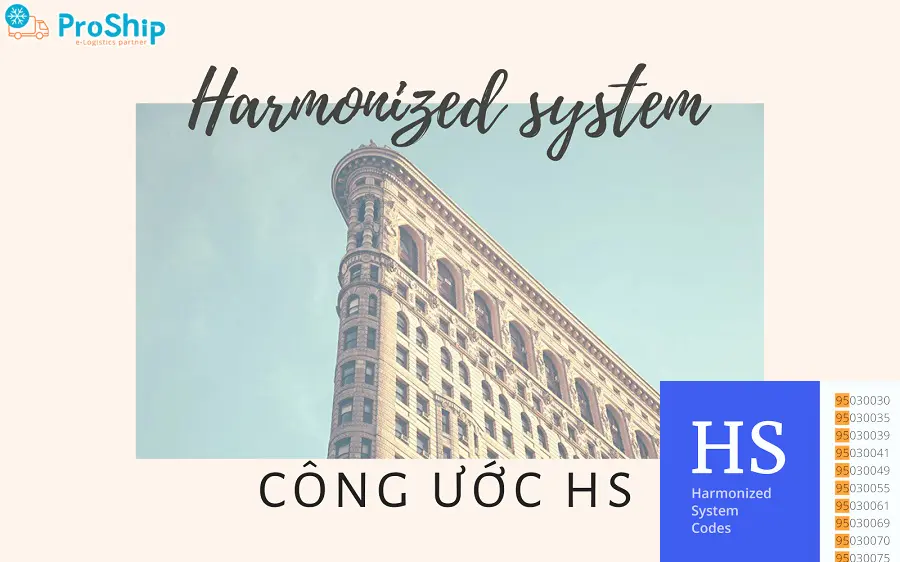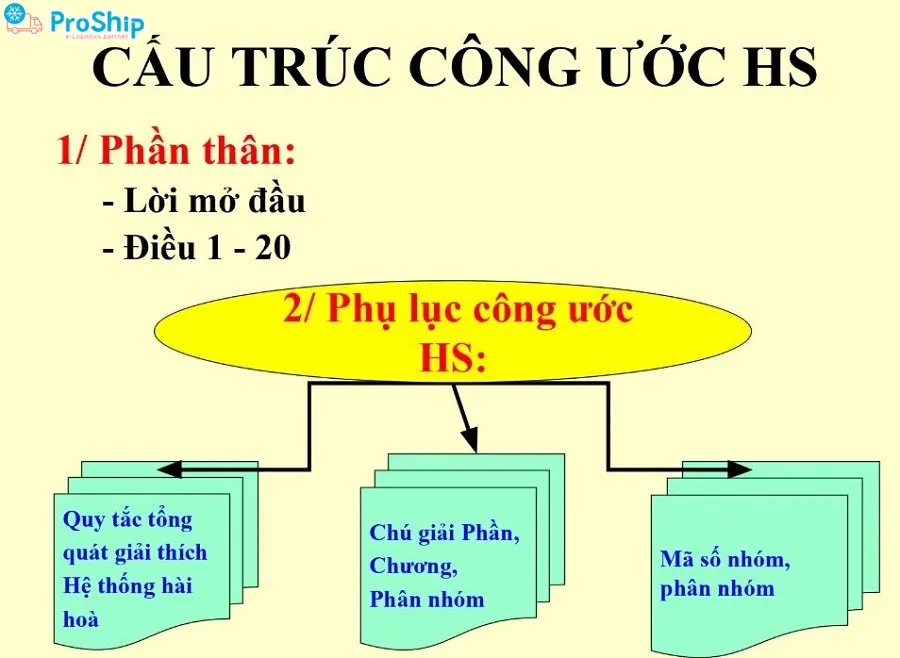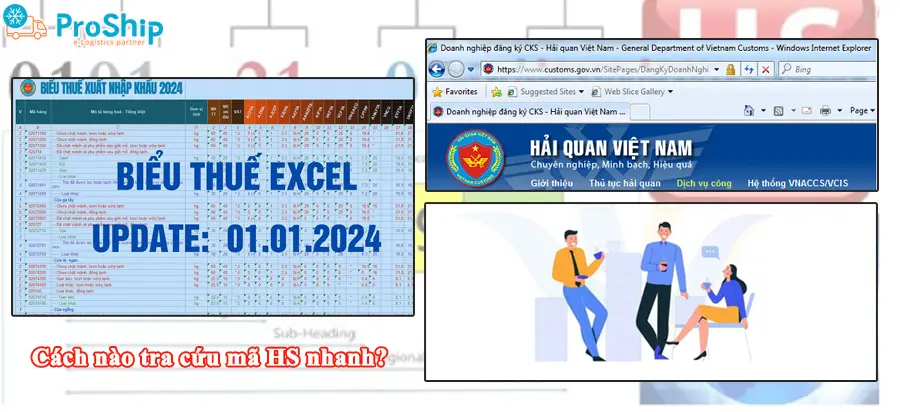x Bạn mới tham gia vào lĩnh vực XNK, Logistics và đang thắc mắc Công ước HS là gì, được quy định ra sao?
x Bạn quan tâm và muốn tìm hiểu tất tần tật thông tin liên quan tới HS Công ước để thuận tiện cho quá trình xuất, nhập hàng hóa?
x Bạn muốn biết cấu trúc, vai trò, cách tra cứu mã HS Code nhanh nhất?
Trong khuôn khổ bài viết này, Proship.vn chúng tôi sẽ cập nhật cho bạn kiến thức cần biết về công ước HS là gì, mục tiêu là gì, quy định thế nào,…để những ai mới tham gia vào lĩnh vực XNK, Logistics có thể nắm rõ và hiểu đúng về công ước HS quan trọng này.
ĐỌC THÊM: Dịch vụ vận chuyển Container nội địa giá rẻ
Công ước HS là gì?
Công ước HS là gì? Công ước HS tiếng Anh là “Harmonized System”, viết tắt là HS. Công ước HS (Harmonized system) tên đầy đủ là “Công ước quốc tế về hệ thống hài hòa mô tả và mã hóa hàng hóa” được tổ chức hải quan thế giới thông qua tại Bỉ năm 1983, có hiệu lực ngày 01/01/1988. Hiện đã có gần 180 tổ chức Hải quan trên Thế giới tham gia và sử dụng Công ước HS.

Công ước HS có ý nghĩa, vai trò quan trọng ra sao?
Công ước HS có ý nghĩa, mục tiêu và vai trò rất quan trọng:
Ý nghĩa, mục tiêu của Công ước HS
Công ước HS ra đời là công cụ pháp lí hữu hiệu nhất đảm bảo cho hệ thống hài hòa mô tả và mã hóa hàng hóa nhờ đó trở thành một hệ thống phân loại hàng hóa toàn cầu.
Mục tiêu của Công ước HS là cơ sở xây dựng hệ thống phân loại hàng XNK và thuế quan; thống kê thương mại quốc tế; xác định xuất xứ hàng hóa; và đàm phán thương mại giữa các quốc gia.
Vai trò của HS
HS có vai trò quan trọng trong việc:
- Thống nhất cách phân loại hàng hóa theo danh mục chung;
- Thống kê thương mại quốc tế;
- Xác định xuất xứ của hàng hóa;
- Quản lý, kiểm soát hàng hóa XNK.
Cấu trúc công ước HS gồm các phần nào?
Công ước HS gồm 2 phần là Phần thân và Phần phụ lục:
Phần thân
- Lời mở đầu;
- Điều 1: Các định nghĩa;
- Điều 2: Phụ lục;
- Điều 3: Nghĩa vụ của các Bên Tham gia Công ước;
- Điều 4 Áp dụng từng phần đối với các nước đang phát triển;
- Điều 5: Trợ giúp kỹ thuật cho các nước đang phát triển;
- Điều 6: Ủy ban Hệ thống Điều hòa;
- Điều 7: Những chức năng của Uỷ ban;
- Điều 8: Vai trò của Hội đồng;
- Điều 9: Thuế suất Hải quan;
- Điều 10: Giải quyết tranh chấp;
- Điều 11: Tư cách để trở thành Bên Tham gia Công ước;
- Điều 12: Thủ tục để trở thành Bên Tham gia Công ước;
- Điều 13: Hiệu lực của Công ước;
- Điều 14: Áp dụng Công ước tại các khu vực lãnh thổ phụ thuộc;
- Điều 15: Rút khỏi Công ước;
- Điều 16: Thủ tục về bổ sung sửa đổi;
- Điều 17: Quyền hạn của các Bên Tham gia Công ước đối với Hệ thống Điều hòa;
- Điều 18: Bảo lưu;
- Điều 19: Các thông báo của Tổng Thư ký;
- Điều 20: Đăng ký lưu chiểu tại Liên hợp quốc.

Phần phụ lục công ước HS
- Quy tắc tổng quát giải thích Hệ thống hài hòa (gồm 6 quy tắc);
- Chú giải Phần, Chương, Phân nhóm;
- Mã số Nhóm, phân nhóm.
NÊN ĐỌC: Giá thành vận chuyển Container lạnh tốt nhất thị trường
Công ước HS đối với các nước đang phát triển
Công ước HS là gì đã được giải đáp ở trên. Tiếp theo là những quy định liên quan tới công ước này đối với các quốc gia đang phát triển:
Áp dụng từng phần của các nước đang phát triển
1. Bất cứ Bên Tham gia Công ước nào là nước đang phát triển được áp dụng chậm một số hay toàn bộ những Phân nhóm hàng của Hệ thống Điều hoà trong một thời hạn cần thiết tùy theo những chuẩn mực thương mại quốc tế hay theo những khả năng hành chính của nước đó.
2. Bên Tham gia Công ước là nước đang phát triển, lựa chọn áp dụng từng phần Hệ thống Điều hoà theo những qui định của Điều này, thoả thuận nỗ lực cao nhất để tiến đến áp dụng đầy đủ Hệ thống Điều hoà với cấp sáu chữ số trong vòng năm năm kể từ thời điểm Công ước này bắt đầu có hiệu lực đối với Bên Tham gia Công ước này hay trong một thời hạn xa hơn nếu nước đó thấy cần thiết theo những qui định tại đoạn 1 của Điều này.
3. Bên Tham gia Công ước là nước đang phát triển, lựa chọn áp dụng từng phần Hệ thống Điều hoà theo những qui định của Điều này, sẽ áp dụng toàn bộ hay không áp dụng toàn bộ những phân nhóm cấp hai của bất kì một phân nhóm cấp một nào, hay áp dụng toàn bộ hay không áp dụng toàn bộ những phân nhóm cấp một của bất kì một nhóm nào.
4. Nước đang phát triển, lựa chọn áp dụng từng phần Hệ thống Điều hoà theo những qui định của Điều này, khi trở thành Bên Tham gia Công ước sẽ phải thông báo cho Tổng thư kí về những phân nhóm mà nước đó chưa áp dụng vào thời điểm khi Công ước này có hiệu lực đối với nước đó và cũng sẽ phải thông báo cho Tổng Thư kí về những Phân nhóm mà nước đó sẽ áp dụng.
5. Bất cứ nước đang phát triển nào, lựa chọn áp dụng từng phần Hệ thống Điều hoà theo những qui định của Điều này, khi trở thành Bên Tham gia Công ước có thể thông báo cho Tổng thư kí là mình chính thức chịu trách nhiệm áp dụng toàn phần Hệ thống Điều hoà ở cấp độ sáu chữ số trong thời gian ba năm kể từ thời điểm Công ước này có hiệu lực đối với nước đó.
6. Bất cứ Bên Tham gia Công ước nào là nước đang phát triển áp dụng từng phần Hệ thống Điều hòa theo những qui định của Điều này sẽ được miễn trách nhiệm về những nghĩa vụ theo Điều 3 với những phân nhóm hàng chưa áp dụng.
Trợ giúp kĩ thuật cho các nước đang phát triển
Các Bên Tham gia Công ước là những nước phát triển sẽ cung cấp cho các nước đang phát triển, theo như được yêu cầu, trợ giúp kĩ thuật trong khuôn khổ thoả thuận song phương, trong đó có đào tạo cán bộ, chuyển đổi các hệ thống danh mục hiện hành sang Hệ thống Điều hoà và cố vấn về việc cập nhật vào những hệ thống đã được chuyển đổi đó của họ những sửa đổi bổ sung của Hệ thống Điều hoà hoặc áp dụng những qui định của Công ước này.
(Trích dẫn nguồn Tài liệu tham khảo: Điều 4, Điều 5 Công ước HS)
Hướng dẫn cách tra cứu mã HS nhanh nhất
Cách 1: Tra cứu mã HS trên Website
- Qua Website Hải quan Việt Nam: https://www.customs.gov.vn/
- Qua Website tra cứu HS quốc tế: https://www.exportgenius.in/hs-code/vietnam
Cách 2: Tra cứu trên biểu thuế XNK Việt Nam
- Bước 1: Để tra cứu nhanh chính xác, cần nắm vững 6 quy tắc tra cứu HS code;
- Bước 2: Mở file Bảng biểu thuế XNK, sau đó ấn phím CTRL + F, nhập từ khóa liên quan đến hàng hóa vào ô tìm kiếm, tìm kiếm và tra cứu các mã HS code phù hợp với mô tả, chủng loại,…

Cách 3: Hỏi người có kinh nghiệm
- Bạn có thể hỏi những người đã có kinh nghiệm (Anh/Chị đồng nghiệp trong công ty, nhóm, đối tác) đã làm nhiều lô hàng đó nhiều lần;
- Hoặc có thể hỏi các Công ty Logistics, Công ty cung cấp dịch vụ thông quan hàng hóa hoặc có thể hỏi trên các hội, nhóm, diễn đàn về XNK.
Công ước HS là gì cùng những thông tin liên quan tới công ước HS đã được chuyển tải một cách đầy đủ, chi tiết nhất. Proship Logistics là một trong những Đơn vị chuyên cung cấp Dịch vụ Vận tải Đa phương thức giá rẻ và có nhiều kinh nghiệm về mã HS Code đa dạng mặt hàng. Mọi thắc mắc, liên hệ ngay 0909 344 247 để được tư vấn, giải đáp và cung cấp các dịch vụ liên quan.
